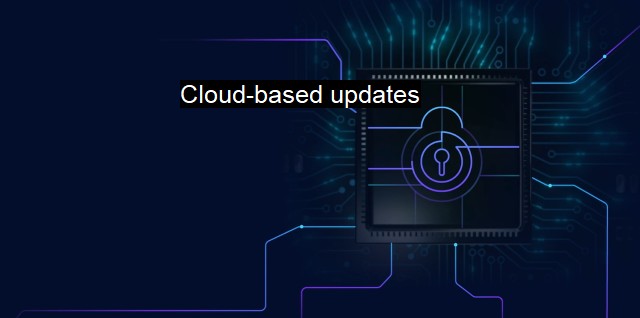What are Cloud-based updates?
How Cloud-based Updates Enhance Cybersecurity and Antivirus Protection
Cybersecurity is a growing concern in our technologically driven society. As we become increasingly reliant on digital technologies for work, communication, and daily life, maintaining secure and clean operating systems has become paramount. Antivirus software, one tool used for cybersecurity, consistently updates to provide the best and most effective virus coverage. One way it gets these updates is through a system referred to as "cloud-based updates."In the simplest terms, cloud-based updates refer to the process of downloading the latest antivirus patches, signatures, and software enhancements directly from the internet. The "cloud" refers to servers on the internet where data is stored and accessed. Comparatively, traditional forms of antivirus updates get downloaded and installed manually by the user or automated through the system that installs them from your local machine to a server before distributing them back. The process is not only laborious but increases the chances of errors and inconsistencies.
Cloud-based updates pose significant advantages over traditional forms with robust, automatic, and seamless corrections and migrations. First and foremost, cloud-based updates are incredibly fast. Security companies can rapidly roll out new patches or definitions as soon as they detect a new virus or vulnerability and push it to devices worldwide. Disseminating new patches through the cloud negates the need to wait for scheduled updates, allowing systems to remain up-to-date and protected against newly discovered viruses in real time.
Secondly, the cloud-based updates get distributed automatically. This rollout eliminates the need for users to manually check for new updates, reducing human intervention and the possibility of missing crucial updates. Automatic update distribution has allowed thousands of organizations to maintain their cybersecurity strengths without subjecting their Information Technology or IT departments to intensive, overarching manual tasks.
Cloud-based updates are incredibly efficient. They minimize downtime since the updates usually happen in the background, without requiring a system restart or causing disruptions. The user can carry on with their tasks without interference, facilitating a smoother cybersecurity maintenance process.
Besides, cloud-based updates require less computational resources on devices as much of the processes happen on the cloud servers. Thus, there is much less pressure placed on local memory and processing capabilities of individual computers.
With less reliance on physical infrastructure, cloud-based updates help increase environment sustainability efforts. Reducing waste and energy usage as we are no longer dependent on the equipment's lifecycle, instead, we remain independent of physical boundaries and infrastructure and only require connectivity and internet accessibility to perform updates.
Cloud-based updates also ensure comprehensive protection. Traditional antivirus software relied on system scans that needed the latest virus definitions. These definitions had to reside on the device, taking up considerable hard drive space and processing resources. In contrast, cloud-based antivirus solutions contain these definitions on their servers, ensuring the latest definitions are always available for scans, offering the most comprehensive threat detection.
Lastly, cloud-based updates come with interoperability advantages across different systems and platforms. Their consistency and device-agnostic model make cloud-based cybersecurity a preferred choice for many businesses today.
The positive attributes of cloud-based updates should not pixelate the necessary considerations like having stable and reliable internet access and potential cybersecurity risks that could emerge from unpredictable cloud security threats. Organizations must work closely with trusted cloud-based security providers and employ strict safety protocols to mitigate these risks.
Cloud-based updates have paved the ways to holistic and practical cybersecurity in the age of advanced technology. Synchronizing cybersecurity efforts and providing real-time updates, these changes shield our systems against evolving digital threats. As we progressively navigate through an innovative, fast-paced digital sphere, the significance of cloud-based updates will continue to escalate, shaping cybersecurity efforts and governing the principles of future antivirus deployment.

Cloud-based updates FAQs
What are cloud-based updates?
Cloud-based updates are updates that are delivered from a remote server, known as the cloud. These updates are designed to improve the performance and security of software, including cybersecurity and antivirus software.What are the benefits of cloud-based updates for cybersecurity and antivirus?
Cloud-based updates offer several benefits for cybersecurity and antivirus. They allow for faster and more efficient delivery of updates, which helps to ensure that systems are protected against the latest threats. Additionally, cloud-based updates can be delivered automatically, reducing the need for manual intervention and allowing for more consistent updating.How secure are cloud-based updates for cybersecurity and antivirus?
Cloud-based updates for cybersecurity and antivirus are generally very secure. The updates are delivered over secure, encrypted connections, and the cloud providers that deliver them have extensive security measures in place to protect against unauthorized access and data breaches.Do I need to manually update my cybersecurity or antivirus software if I have cloud-based updates?
In most cases, no. Cloud-based updates are designed to be delivered automatically, so you typically won't need to manually update your cybersecurity or antivirus software. However, it's important to ensure that your system is configured to receive these updates automatically and that you have a reliable internet connection to receive them.| | A | | | B | | | C | | | D | | | E | | | F | | | G | | | H | | | I | | | J | | | K | | | L | | | M | |
| | N | | | O | | | P | | | Q | | | R | | | S | | | T | | | U | | | V | | | W | | | X | | | Y | | | Z | |
| | 1 | | | 2 | | | 3 | | | 4 | | | 7 | | | 8 | | |||||||